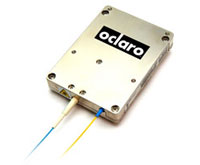Mar 19 2010
Oclaro, Inc. has recently introduced the Indium Phosphide-based 40G RZ-DQPSK transponder for C-band, wideband-tunable applications that require a dispersion tolerance of 150ps/nm to +150ps/nm for use in noise-loaded links.
 The Indium Phosphide-Based Transponder
The Indium Phosphide-Based Transponder
Oclaro is a supplier of optical subsystems, modules, and components for the telecom sector. The transponder meets the Telcordia standards and delivers high performance within a 300 pin, low-cost Multi-Source Agreement (MSA) platform. Oclaro is offering this product for its tier-one customers to help them in advanced field deployments.
Paul Johnson, Oclaro’s Product Line Manager for 40G Modules, informed that these 40G transponders prove the commitment of Oclaro to continually enhance the functionality and bandwidth of the network and at the same time has lowered the end-user expenses. Johnson added that the booming Indium Phosphide technology incorporated into the MSA platform helps Oclaro not only in enhancing the overall system performance but also in reducing costs to a large extent.
The multi-rate adaptable transponder provides a significant improvement in OSNR as compared to traditional DPSK systems that are designed with a channel spacing of 50GHz. These transponders form the latest additions to the entire folio of Oclaro products that are utilized for powering the regional or metro network infrastructure. These transponders have been tested rigorously as per Telcordia standards to guarantee maximum reliability. Telcordia standards stipulate 2000 hours of damp heat, active endurance, vibration, shock, and temperature cycling testing.
The selection of the RZ-DQPSK format along with the expert usage of Indium Phosphide technology has helped Oclaro to establish unique standards in features, cost, and performance of 40G transponders. Customers of Oclaro can leverage the vertical integration power that enables features differentiation at the chip level thus enabling cost disruption.